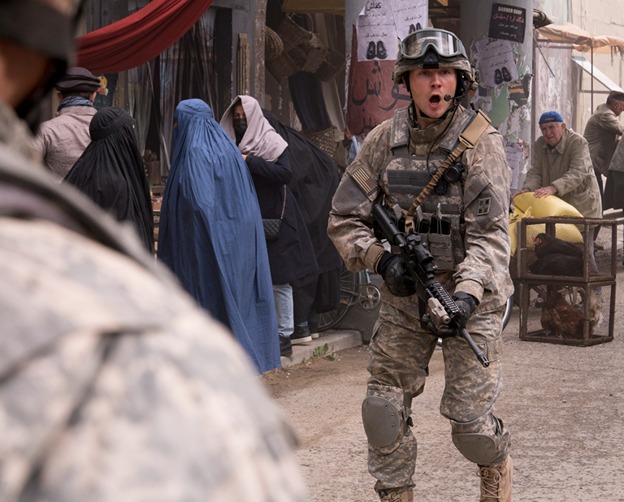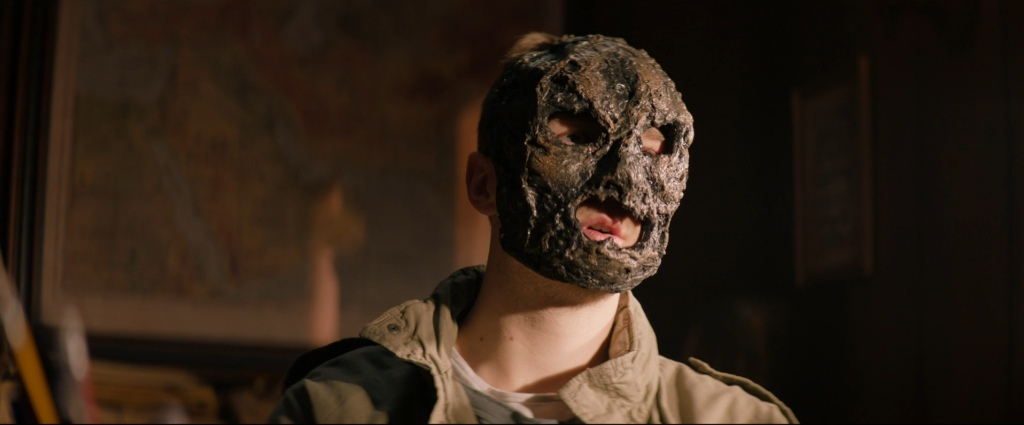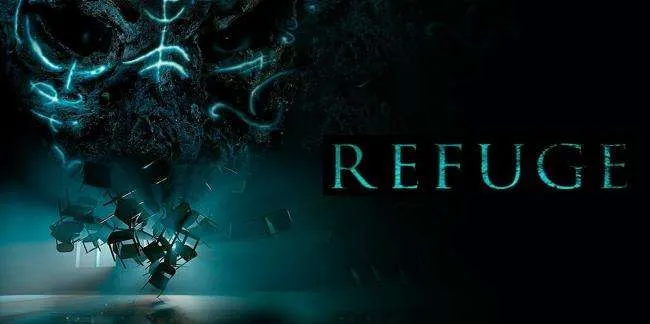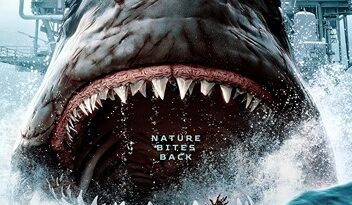In “Refuge”, PTSD And Arabic Demon Meet. The Result Is Mainly Messy | Review
There is no shortage of horror films that deal with trauma, and even post-traumatic stress disorder (PTSD). Each film has its specific context, in terms of time and place. Still, the idea is that exposure to a “horror film” in the terrifying conditions of war or acts of terrorism will leave damage – physical, but also mental – that is difficult to recover from, with countless triggers and consequences for behavior. “Refuge” is a pretty small film that takes this idea of a post-traumatic stress disorder caused by war and turns it into an exorcism film with a demon character from Arab mythology and a few more ideas. This film moves between several genres and also tries to weave messages about war.
The critical question is how successful the final result is, and here my opinions are divided. Behind “Refuge” is a skilled director (Renny Harlin), a cast that does the job overall (especially stunning Sophie Simnett), and a few surprises regarding the script or scares. On the other hand, the film is somewhat messy, includes some weak elements in its work (for example, some dialogues), does not leave a mark, and is undoubtedly not post-traumatic. You can give it a chance, because it’s mostly enjoyable, but it’s worth lowering your expectations.
What Is the Refuge Movie About?
“Refuge” focuses on a soldier named Rick Pedroni (Aston McAuley, “The Personal History of David Copperfield”, “Behind Her Eyes,” and a small role in “Rocketman”), who returns home after military service in Afghanistan. During the service, he experienced a mysterious incident in a cave. In addition, he had to deal with the tragic loss of most of his unit members.
The problem is that something is wrong with him after returning. His wife Kate (the talented Sophie Simnett from Disney’s musical drama “The Lodge” and the series “Daybreak” on Netflix) and father Sebastian (the veteran Jason Flemyng, “Lock, Stock and Two Smoking Barrels,” “Snatch,” “The League of Extraordinary Gentlemen”) discover an apathetic man who does not communicate and is prone to strange and violent behaviors.

They turn to a therapist (Johanna Harlin, the wife of director Rani Harlin who at one point converted from the education system to film industry, was one of the producers of her husband’s “The Strangers: Part 1” and “The Bricklayer, in which she also played), who offers therapy using a mask that the traumatized young man will design for himself. There is also the story of an imam named Ibrahim (Raza Jaffrey, “Harry Brown” and the TV series “Homeland”, “Code Black”, and “Lost in Space”), whose family – and especially his rebellious son, Farid (the Iranian-British Shervin Alenabi, “Tehran”, “Kabul) – feel inferior due to their origin.
Here is the trailer of “Refuge”:
💀 Killer Deals & Scary Recommendations 💀
🎭 Costumes & Accessories
HalloweenCostumes Fun Costumes Entertainment Earth
🛒 Online Shopping
AliExpress Amazon Walmart Etsy
🧛 Collectibles & Horror Brands
Funko Hot Topic Lego Spirit Halloween
🎢 Attractions & Tours
GetYourGuide Tiqets Viator Klook
📖 Blogs & Horror Sites
Bloody Disgusting iHorror Fangoria
🩸 Disclaimer: Some links are affiliate links. The price stays the same – it just helps keep the site alive 👻
The Dark Side Of The Djinn
At a certain point, the film takes on a mythological dimension. We understand that Rick Pedron’s experience in Afghanistan may be related to his encounter with a Djinn, which is, of course, different from the most familiar representation of the Djinn in modern culture: that funny turquoise-blue demon who emerges from the magic lamp in “Aladdin” and allows the hero to fulfill three wishes. Djinns are also mentioned in the Quran and can be good or wicked.
On the positive side, the Djinn may protect against the evil eye. On the other hand, according to Islam, where Satan is none other than a Djinn who refused God’s command to bow down to humans, the Djinn may deceive man. According to the apparent literal meaning from Arabic, we use the word “Majnun” to describe a crazy person, and the crazy person is such because “a demon has entered him,” that is, a “Djinn.”
The film doesn’t explain exactly what the genie’s abilities are, or as it’s sometimes called here, “some Arab demon,” but it’s clear that they go beyond granting wishes. From this point, we get a sort of Muslim version of “The Exorcist,” with the familiar ideas: you know, a person who frighteningly stares into the air, with glowing eyes and supernatural abilities that also pass on to other people who are possessed (and there are quite a few of them in this film). Ultimately, science needs to cooperate with faith, and people from other religions must work together, so it’s possible to think about defeating the demon.
The Ghosts Of War Are Still Here
You don’t have to be a great expert in the psychology of the mind to see that “Refuge” essentially takes the idea of war trauma and dresses it up in the clothes of a generic horror movie about exorcism, ghosts, and everything in between. As you may recall, this is not a new idea – we have seen many horror films that deal with trauma or loss, such as “The Babadook, “Hereditary”, “Rosemary’s Baby”, “The Descent”, “The Others”, “Mother!”, “Saint Maud” and others – in which the trauma can come in the form of a ghost, a monster, psychotic behavior, human experimentation, a dancing broccoli, or whatever.
“Refuge” is also not the first film to deal with the demons of war: it was preceded by, for example, “Red Sands”, “Ghosts of War”, “Overlord”, and others. Perhaps the greatest classic in this context is Adrian Lyne’s excellent “Jacob’s Ladder”, in which Tim Robbins plays a soldier discharged from Vietnam who experiences visions and hallucinations, to the point of completely blurring the boundaries between reality and imagination.
In “Refuge,” there is a combination of dealing with trauma with Arab folklore with a modern discussion, and it all comes with a contemporary debate about war, racism, immigration, and so on. If we stick to the conversation that appears in many cultured about every film that deals with war, some will see the film as “right-wing” and some will argue that it is too “left-wing,” but the bottom line is that the film does not seem to have decided which direction it is heading.

Refuge Is A film by Renny Harlin. For Better Or Worse
“Refuge” was directed by the veteran Finn Renny Harlin, who has worked in Hollywood for almost four decades. Behind him is a very long list of films, whether blockbuster action thrillers (“Die Hard 2,” “Cliffhanger,” “Deep Blue Sea”) or horror films (“A Nightmare on Elm Street 4: The Dream Master,” “Exorcist: The Beginning,” “Mindhunters”). We recently saw Harlin brought back to life, not very successfully to be honest, “The Strangers”, with a film that’s not really clear what he wants to be. Two more films in the renewed trilogy will follow, also directed by him.
On the one hand, it’s hard to argue that “Refuge” is one of the most significant films in Rani Harlin’s filmography: in fact, if you check Wikipedia, you’ll discover that out of something like 30 films he directed or produced over his long carreer, “Refuge” is currently the only one without its own Wikipedia article (!). On the other hand, the film shows that Harlin knows how to make cinema. The production looks excellent, including the use of locations and lighting, which, for a change, allows us to see something even when the frame is dark. The representation of the villains – people with creepy masks and some computer effects – does the job overall. It seems that some of the masks are here to perhaps audition for the subsequent “The Strangers” films, also by Harlin, but they have a creepy side.

You feel a skilled hand behind “Refuge” from the first moment. Still, this may also be its biggest problem. Harlin doesn’t seem to have quite decided what direction the film should go in or its primary genre. While stories of this kind are usually presented as family dramas where we care about the characters and their development, there are too many characters and stories, which is a bit off-putting. Too many people are affected by the demon here, to the point where we get something that looks like another Romero movie about a zombie epidemic. The overall feel is chaos and disarray, a messy film in style, narrative, or pacing. According to reports, the film was edited hastily after another Renny Harlin project was canceled, and you can tell it sometimes.
In my opinion, the mass scenes damaged the DNA of the film and made it much less scary than it could have been. Not only on an execution level, but also psychologically. Because with all due respect to terms like “collective trauma,” which are valid to a certain extent, any such case of psychological harm – and I apologize in advance for the worn-out term – is a world in itself. If we had stuck mainly to the character of the traumatized soldier and developed it more, the average viewer might have cared more about what he sees on screen, even in the emotional aspect.
How Was The Cast of Refuge?
The actors mostly do their job, even if it seems that in some cases they had difficult (and especially not very believable) dialogues to deal with. Sophie Simnett stole the show in my opinion, with a fairly versatile and sensitive display, including some sense of humor, and I would love to see her break out with a few more horror films. Raza Jaffrey as the Imam, or should we say “the Exorcist,” also managed to create an engaging and sympathetic character.
The representation of the traumatized soldier was flawed in my opinion because the choice was for an overly anemic character who looks like a zombie, rather than a character who realistically deals with a situation that could happen in our world. It’s not that there aren’t battle-scarred soldiers who have trouble speaking or functioning, unfortunately, but here the changes in the characters seemed a bit superficial and random. Several supporting characters were flawed and underdeveloped, such as the imam’s son and the attending doctor, who also starred in a rather unnecessary ending scene that is far from clear.

Should You Watch Refuge?
Ultimately, “Refuge” is not one of the most significant horror films we’ve seen in recent years, nor Renny Harlin’s prosperous career. Still, I found some good points in it, combined with polished cinematic work, which makes the film look and feel good at specific points. On the other hand, it also has flaws that explain why the film is far from well-known and has received mostly bad reviews.
It’s mostly suitable for casual late-night viewing, and sometimes that’s what we need.
Refuge (2023) – Frequently Asked Questions
Who Directed Refuge? The film’s director is Finnish filmmaker Renny Harlin, known for horror films and some blockbusters.
Who plays in Refuge? The cast of the film includes Aston McAuley, Sophie Simnett, Jason Flemyng, Johanna Harlin, Raza Jaffrey, and Shervin Alenabi.
Who wrote Refuge? Ben Sztajnkrycer is the film’s screenwriter.
How long is Refuge? The running time of the film is about 91 minutes.
Where was the movie filmed? Refuge was filmed in the United States and Bulgaria.
What languages are spoken in the Refuge? English, with a few sentences in ancient Arabic.
When was Refuge released? The film’s official release date in the United States is April 19, 2024. Its theatrical release was very minimal.
What was the budget of Reduge? Undisclosed
How much did the Refuge movie gross worldwide? We didn’t find any data on the film’s grosses. Although it was shown in some country theaters for a while, its worldwide theatrical distribution was minimal.
What was the MPAA rating (Parental Guidance) of the film? Refuge is rated R for violent content, suicide, language, and some sexual content (no nudity).
What do the reviews say about Refuge? The overall rating of the film on IMDB is 4.2 out of 10. There aren’t enough reviews on Rotten Tomatoes to get a “Tomatometer” score.





